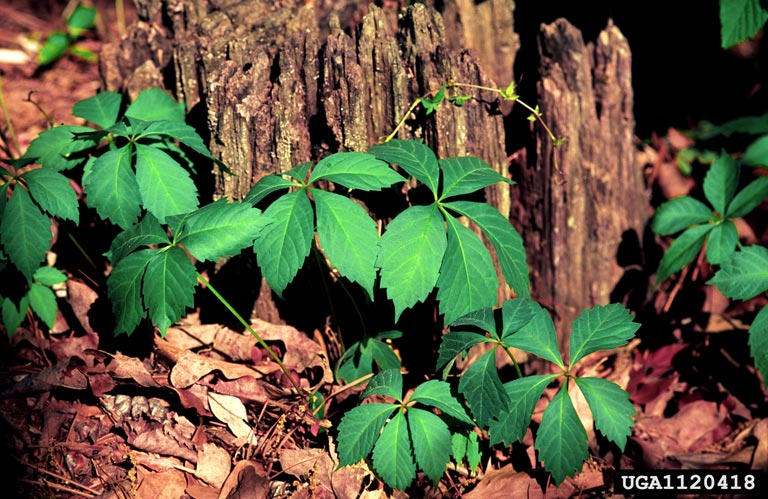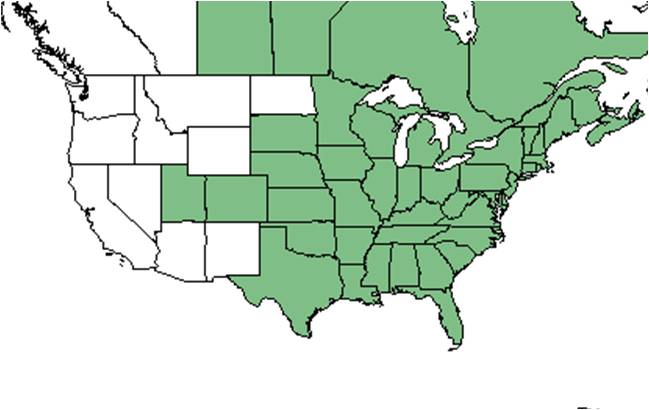Difference between revisions of "Parthenocissus quinquefolia"
(→Conservation and Management) |
|||
| Line 3: | Line 3: | ||
{{taxobox | {{taxobox | ||
| name = Parthenocissus quinquefolia | | name = Parthenocissus quinquefolia | ||
| − | | image = | + | | image = Part_quin.jpg |
| − | | image_caption = | + | | image_caption = Photo by James H. Miller & Ted Bodner, Southern Weed Science Society, [http://www.forestryimages.org/index.cfm Bugwood.org] |
| regnum = Plantae | | regnum = Plantae | ||
| divisio = Magnoliophyta - Flowering plants | | divisio = Magnoliophyta - Flowering plants | ||
Revision as of 15:33, 29 June 2016
| Parthenocissus quinquefolia | |
|---|---|

| |
| Photo by James H. Miller & Ted Bodner, Southern Weed Science Society, Bugwood.org | |
| Scientific classification | |
| Kingdom: | Plantae |
| Division: | Magnoliophyta - Flowering plants |
| Class: | Magnoliopsida – Dicotyledons |
| Order: | Rhamnales |
| Family: | Vitaceae |
| Genus: | Parthenocissus |
| Species: | P. quinquefolia |
| Binomial name | |
| Parthenocissus quinquefolia (L.) Planch. | |

| |
| Natural range of Parthenocissus quinquefolia from USDA NRCS Plants Database. | |
Common name: Virginia creeper
Contents
Taxonomic notes
Synonym: Parthenocissus hirsuta (Pursh) Graebner
Description
"High climbing vine with white pith and many tendrils with adhesive disks. Leaves palmately compound, petiolate; leaflets 3-7, usually 5, ovate, elliptic, or obovate, to 15 cm long and 8 cm wide, glabrous, usually pale beneath, occasionally pubescent, acuminate, coarsely serrate, usually above the middle of the blade, base cuneate or oblique, petiolulate. Inflorescence a panicle of cymes. Calyx flat, usually without lobes; petals 5, separate, yellowish green, 2-3 mm long; disk small, adnate to ovary; stamens 5, filaments short; style ca. 0.5 mm long. Drupes black or dark blue, globose, 5-9 mm in diam.; seeds 1-3, lustrous brown, planoconvex, obovoid, 3.5-4 mm long." [1]
Distribution
Ecology
Seed dispersal
According to Kay Kirkman, a plant ecologist, this species disperses by being consumed by vertebrates (being assumed). [2]
Pollination
The following Hymenoptera families and species were observed visiting flowers of Parthenocissus quinquefolia at Archbold Biological Station (Deyrup 2015):
Apidae: Apis mellifera
Colletidae: Colletes nudus
Halictidae: Augochloropsis anonyma, A. metallica
Megachilidae: Coelioxys sayi, Megachile mendica
Pompilidae: Episyron conterminus posterus, Tachypompilus f. ferrugineus
Vespidae: Mischocyttarus cubensis, Parancistrocerus fulvipes rufovestris, P. perennis anacardivora, Polistes bellicosus, Stenodynerus beameri, Vespula squamosa
Conservation and management
Cultivation and restoration
Photo Gallery
References and notes
Deyrup, M.A. and N.D. 2015. Database of observations of Hymenoptera visitations to flowers of plants on Archbold Biological Station, Florida, USA.